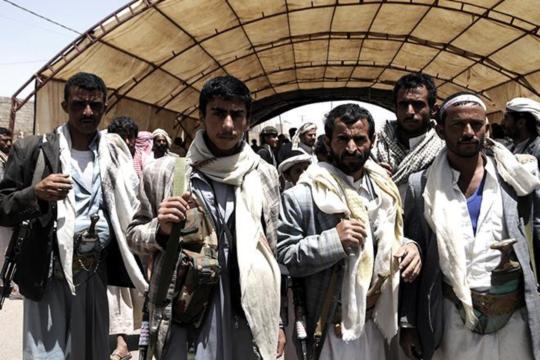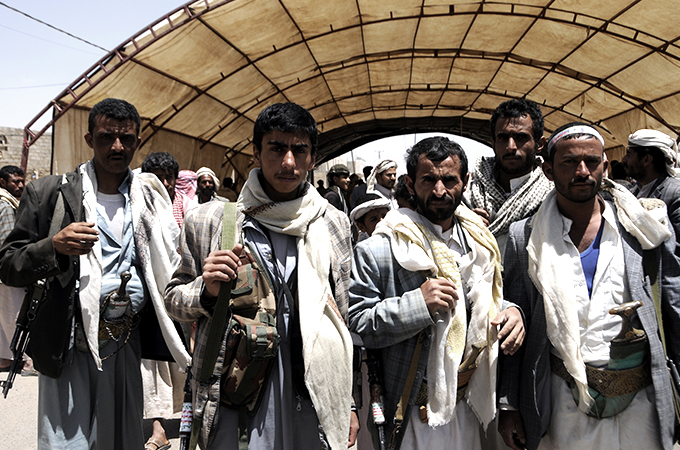
 |
| Shiite gunmen gather at a site of the Shiite Houthi movement in Hamdan district, Yemen, 23 March 2014 [EPA/Yahya Arhab] |
| Abstract In the three years since the start of the 2011 youth revolution, the Houthi movement has achieved remarkable military expansion into five northern Yemeni governorates outside its operations headquarters in Saada governorate. The Shiite movement has demonstrated solid military capability that has in turn allowed it to simultaneously fight on several fronts. This paper discusses the three possible trajectories for the movement given that it is difficult to ascertain its aims, strategic objectives and future course. First, it is possible the movement will gain military dominance. Second, it could pursue civilian integration. Finally, the movement could pursue a hybrid of military and civil society building activities. The movement’s internal dynamics and the extent to which Yemeni and regional players can influence it will be the deciding factor. |
Introduction
Taking advantage of Yemen’s political and economic challenges that come with transitional phases, the Shiite Houthi movement has managed to expand its operations beyond its normal operation headquarters in Saada, now maintaining a presence across the country. Concurrently, the movement seems to have a double message: on the one hand, it adopts a political narrative of integrating into a civil state governed by a constitution, rule of law and outcomes of national dialogue. On the other hand, it assumes a sectarian and religious position as a revivalist and Jihadist movement contradictory to its political narrative and demands for a civil state. This raises several questions about the movement’s objectives as well as possible outcomes of oscillation between military action and civic integration. This paper discusses three possible trajectories for the movement as well as the stance of domestic, regional and international players.
Aims of military expansion unclear
Over the past three years, the Houthi movement has militarily expanded into five northern governorates. In the past two months alone, it has achieved a series of military victories against opponents in Kitaf and Damaj, including victories against the Salafists and tribal and Jihadist forces allied with them, a state-sponsored reconciliation agreement driving the Damaj Salafists out of Saada, significant victories against the Ahmar tribal league, military campaigns against the Islamic Islah (reform) allied tribes and the opening of a new front in the Hamdan region only 12 kilometres away from the capital.
Both on a local and regional level, the Houthi movement has taken advantage of current weaknesses, the political apparatus’ transition challenges and political change in the country and region to achieve its recent military victories. First, there is an intersection of interests between the Houthi movement and former President Ali Abdullah Saleh, and the Houthi movement has benefited from Saleh’s political and social influence in destroying common enemies such as the Hashed tribal group. Second, the Houthi movement has dropped as a priority on Saudi’s list of threats, being replaced instead with the Muslim Brotherhood.
As for the aims of the Houthi movement’s military expansion, there are several possibilities. First, the movement, in collaboration with the previous government, is attempting to thwart the transitional effort. Maintaining disorder and disrupting domestic affairs will damage President Abdrabuh Mansur Hadi Mansur’s already-fragile regime. This also serves to dismantle his internal alliances by exhausting him politically and eventually toppling his rule. Second, domestic chaos means the Houthi movement will have further opportunities to score military and territorial gains.
Third, the movement’s military activities give it leverage to pressure the current regime and extract concessions regarding its share in the government. Fourth, military expansion gives the Houthi movement leverage when it commits to reconciliation treaties with local tribes – in every treaty they have signed, they have stipulated that they be given unhindered freedom to disseminate their ideological and religious precepts.
It can be argued, then, that the Houthi movement’s military strategy is part of a larger goal of expanding its presence on the ground in order to facilitate their doctrinal project, one that is incapable of integration into a civic state. Its expansionist tendencies are becoming a cause of greater concern when coupled with hegemonic ambitions and a sectarian agenda – one that includes “liberating” the Islamic nation from forces of “global arrogance” by mobilizing its members as an army fighting for this cause.
Future trends: between dominance and integration
Three trajectories seem possible: the Houthi movement gains military dominance, the Houthi movement integrates into civilian life or the movement pursues a combination of both strategies in a manner similar to Lebanon’s Hezbollah group. The deciding factor will be the movement’s internal dynamics and the extent to which Yemeni and regional players influence its path.
Scenario one: military dominance
The movement bases its legitimacy on its Shia heritage which includes the appearance of Al-Yamani and Al-Mahdi, as well as other major Shia epics – and it classifies those who oppose it as the Islamic nation’s enemies. Because of its sectarian nature and structural inability to integrate into a coalition government, its agenda cannot become a reality without military force.
The reality, then, is that the movement’s revivalist Jihadist agenda indoctrinates its followers religiously and dogmatically, making them fighters for major causes that go beyond local borders and making it difficult to disarm. Furthermore, such a movement will not easily integrate into a political or social structure dependent on peaceful means of control.
In this scenario, the Houthi movement cannot abandon its military agenda, so it will continue to build its military strength while hiding behind civil society discourse. Growth in the military force and control over larger land masses will translate into political power in Yemen, as well as support from forces in the region that have a stake in removing President Hadi. Once the movement has used these forces to its advantage, it will dispose of them, achieving full control over the regime and the state. Geographically and strategically speaking, this will also give it control over the tribal northern mountain plateau, a strategic stronghold of the Zaidi sect and a replica of the Hashemite Imamate’s traditional dominance model in Yemen in past years.
This scenario is difficult to achieve and would throw the country into civil war, something even those opposed to President Hadi do not want. Even if the movement expanded into the Northern plateau, it wouldn’t necessarily be capable of tightening its grip over central regions. On a regional level, this scenario is also problematic for those worried about the expansion of Iranian influence. Some argue that the Houthis wouldn’t have been able to expand militarily in the last few months were it not for the tacit approval of not only domestic but also regional actors sympathetic to external powers, especially those wishing to limit the General People’s Congress’ (GPC) power.
Scenario two: civil state integration
Under this scenario, the Houthi movement will strive to integrate into civil society, forcing it to pursue peaceful means to gain power. There is a very important assumption under which this scenario will unfold, and it is that civil integration will align with the movement’s political demands and that the threats surrounding the movement will fade and retreat. To some extent, they have, and this increases movement members’ support for a civil state option. Furthermore, in such a civil state environment that values diversity, the Houthis will be able to freely disseminate their ideology without the need for military force.
There is another so-called benefit that would result from this scenario, and it is that analysts believe the movement will be forced to moderate its hostile and confrontational sectarian discourse towards Sunnis, resulting in local prevalence and closer realignment to regional parties who have influence over Yemeni affairs.
The option of civil integration and a peaceful settlement of the Houthi issue is a mutual interest for internal and external parties alike because the alternative is chaos, violence and an armed sectarian conflict. President Hadi’s regime can, with the support of the ten countries sponsoring the recent Gulf-UN initiative, impose this option, and compel objecting parties to comply. The initiative’s official name is UN Security Council Resolution 2140 which falls under Chapter VII of the United Nations Charter. It is a powerful tool for the regime and can be used to pressure the Houthis to move on a settlement path towards building the desired civil state or face international sanctions for impeding the transitional process.
The resolution was partly a product of these ten countries’ concern about, among other things, Houthi military expansion towards the capital and the growing trend of conflicting parties resorting to force instead of dialogue. (1) It demonstrated clear international support for disarming local parties and transforming the Houthi Movement into a civil force that competes by peaceful means. On a local level, there is also no desire for conflicts to resort a battle between Sunnis and Shiites, something that would ignite several fronts between the two currents across Yemen, undermining peace and the state’s ability to extend its authority over its territory as well as resulting in a porous internal environment ripe for weapons proliferation and the growth of radical groups.
Scenario three: Hezbollah model in Lebanon
This scenario assumes the Houthi Movement seeks a combination of political integration and military force, reminiscent of the Hezbollah model in Lebanon. This is evident by an aspect of its current conduct and its attempts to use its military ability to expand and penetrate the political system, in turn increasing its power share. For the movement, any disarmament would be linked to building new structures of a civil state and political authority in which it plays the lead. Analysts believe that any concessions about military force will only come after the movement guarantees its place in political institutions. This would be a replica of Hezbollah, which is integrated in the Lebanese state and participates in the political system while maintaining its own military agenda. For Hezbollah, combining political and military powers enabled it to impose itself as on the state and other actors.
The Houthi movement may succeed in achieving integration and maintaining its own military agenda for some time as Hezbollah has done in Lebanon. However, this will not be sustainable in the Yemeni environment which has different external threats, a different social and political environment, a different geographic location and a different significance for international and regional actors.
Should the Houthi movement pursue this third scenario of combining political and military powers, it will probably lead to the militarization of society. In addition, other parties seeking to imitate the movement by combining military and political powers will exacerbate violence and sectarian conflicts in Yemeni society. This could possibly transfer sectarian and political conflict to the state and institutional level, with each party attempting to control them and use them as leverage against each other.
This last possibility is transitional in nature and is expected to evolve over the long term into one of two scenarios: either a return to the civil state option with all parties abandoning their weapons, making it difficult for a single party to impose unilateral control over the rest; or a move towards the gradual collapse of the state, with Yemen sliding towards a sectarian-motivated civil war. This would be an extension of the growing sectarian conflict across the region from Syria to Iraq and Lebanon, fed by external parties that have an interest in fuelling a larger regional sectarian conflict.
___________________________________________________________
(1) Khawlan Press, “Gulf Initiative sponsors concerned over violence to the north of Sanaa”, Khawlan Press,
14 March 2014, http://khawlanpress.net/news_details.php?lang=arabic&sid=516